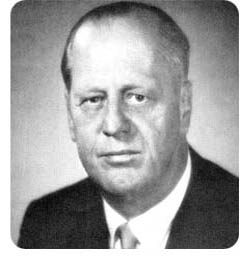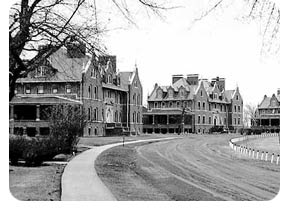Once again, the media proved an ally to those seeking to change the system. Sam Newlund covered the Welsch case for the Minneapolis Tribune, while Ann Baker covered the issue for the St. Paul Pioneer Press.
The state Arc was a primary supporter of the lawsuit. Arc activists Lon Miller and Darlene Olson traveled throughout the state to organize local support.
Welsch Trial Slide Show Photographs from the 1973 trial
On February 15, 1974, Judge Earl Larson issued a 23-page opinion favoring Welsch. Larson wrote, "The evidence is overwhelming and convincing that a program of habilitation can work to improve the lives of Cambridge residents."
Judge Larson continued, "Everyone, no matter the degree or severity of mental retardation, is capable of growth and development if given adequate and suitable treatment."
His ruling guided the service system for the next several years, resulting in reduced resident populations, increased staffing ratios and improved programming.
Video: Luther Granquist, with Anne Henry, both of the Minnesota Disability Law Center, served as plaintiff counsel in the Welsch case.
Part 1: The 45th Anniversary of the Welsch Case Beginning
Part 2: Lack of Individual Assessment and Structured Activity at Cambridge

Judge Larson found overwhelming evidence that "habilitation" programs worked.
The federally-funded Community Alternatives and Institutional Reform project, or CAIR, was chaired by Miriam Karlins, and staffed by the Developmental Disabilities Council. Robert Bruininks served as executive director.
Published in 1975, the CAIR report strongly supported community placements, citing an individual's right to treatment and the principle of normalization being adopted throughout the state.

Community Alternatives and Institutional Reform Project
In the mid-1970s, access to community facilities exploded. In just six years, the number of facilities increased from just 12 in 1970 to 116 in 1976. Two years later, the number had increased to 200.
In the Twin Cities, the Developmental Disabilities Task Force of the Metropolitan Council was created and staffed by Toni Lippert with Mary Hinze as chair.
The process of developing a group home also became more complicated with new steps added such as needs determination, zoning permits, funding and licensing.
Video: Toni Lippert speaks of her work at the Metropolitan Council as the regional planner for developmental disabilities.
Part 1: Special Education for All

Toni Lippert (left) and Mary Hinze (right) led the Metropolitan Council Task Force's efforts to create a consistent process for opening and operating group homes.
Regionalization also continued.
The state institution in Hastings was closed in 1976 and ownership of the Lake Owasso institution transferred to Ramsey County the same year. Both decisions were initiated to fund new activities required under Judge Larson's order.
Noting declining resident populations, the 1976 Comprehensive Plan for the state's Department of Public Welfare called for three additional state hospitals to close by 1980.
The long-range plan cited increased costs and the need to differentiate those who could live in the community from those who could never leave.
In 1978, the Residential Care Study predicted a 30 percent reduction in resident population in five years. It stated that the future should be based on individual need rather than social, economic, and political factors.
Those with the most complex needs informally became known as "the residual population."

In 1976, the state institution in Hastings was closed and its budget was used to fund Judge Larson's orders..
In 1976, the Legislature passed key legislation, including new zoning laws, bonding authorities for group homes and a family subsidy program. Responsibility for the Deaf, Braille, and Sight Saving schools also was transferred to the Department of Education effective in 1977.

Key legislation passed in 1976 created new zoning laws, a bonding authority for group homes and a family subsidy program.
Congress approved Medical Assistance for Intermediate Care Facilities in 1971 and the Fergus Falls State Hospital was the first in the state to be certified to receive federal funds.
Within four years, all state hospitals were certified and Minnesota became the first state to use Medicaid to fund community group homes.

Group homes were opening around the state to allow parents and guardians to choose care that was close to home.
Another state-run facility, the Gillette Hospital, had served children with physical disabilities under the aegis of the Department of Public Welfare for decades. In 1973, it was transferred to a new, quasi-public authority. It continues to be one of Minnesota's premier rehabilitation hospitals.

In 1973, Gillette Hospital no longer operated as part of the state's Department of Public Welfare.









